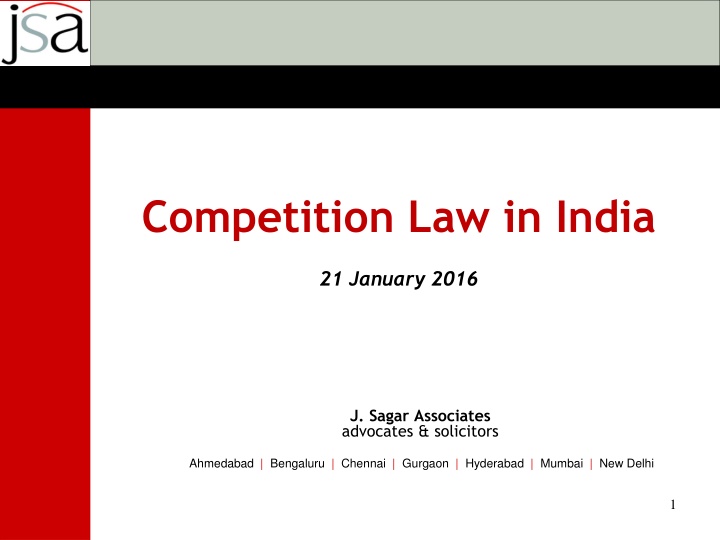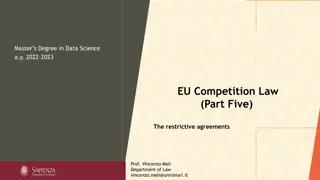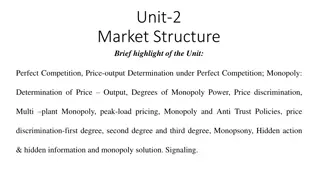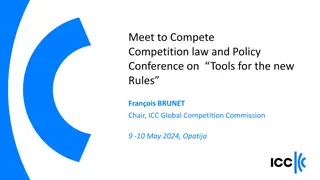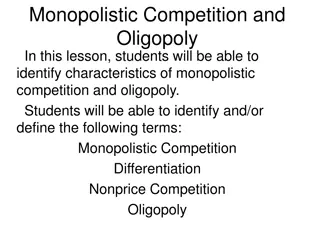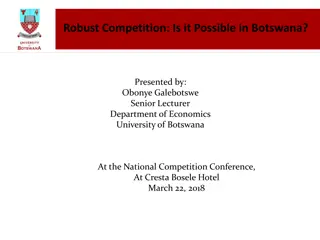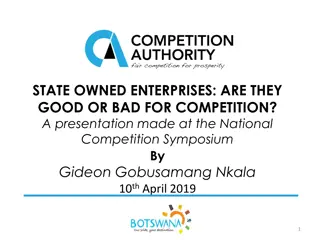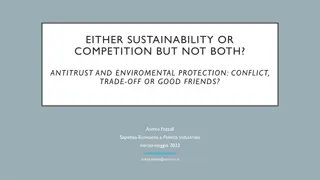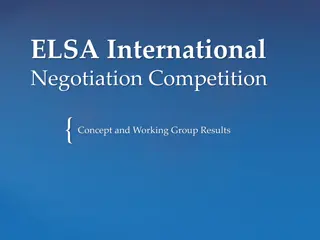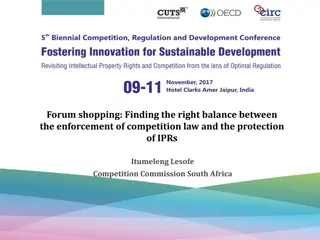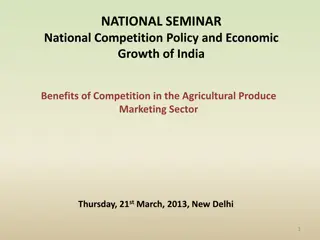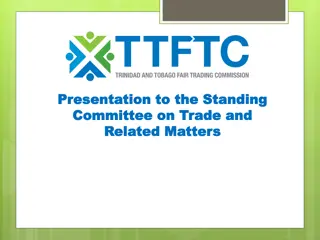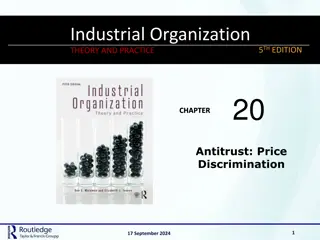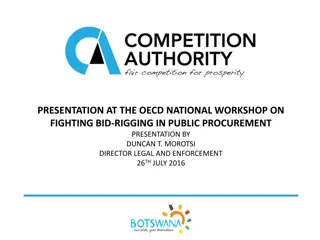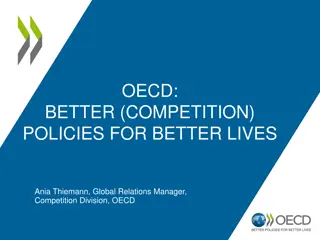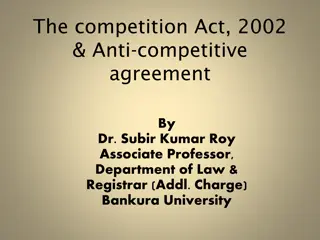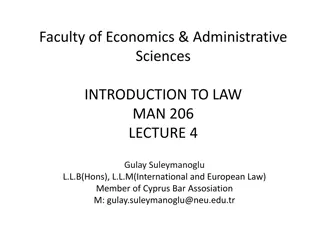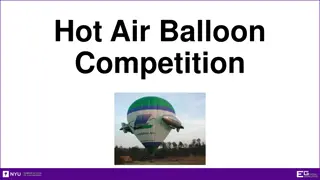Overview of Competition Law in India
Competition Law in India governs anti-competitive agreements, abuse of dominant position, and mergers and acquisitions. It aims to promote fair competition, protect consumers, and prevent monopolistic practices. The law prohibits agreements that have adverse effects on competition and considers various factors to determine anti-competitive behavior. Pro-competitive factors are also taken into account to balance regulation and encourage efficiency in the market.
Download Presentation

Please find below an Image/Link to download the presentation.
The content on the website is provided AS IS for your information and personal use only. It may not be sold, licensed, or shared on other websites without obtaining consent from the author.If you encounter any issues during the download, it is possible that the publisher has removed the file from their server.
You are allowed to download the files provided on this website for personal or commercial use, subject to the condition that they are used lawfully. All files are the property of their respective owners.
The content on the website is provided AS IS for your information and personal use only. It may not be sold, licensed, or shared on other websites without obtaining consent from the author.
E N D
Presentation Transcript
Competition Law in India 21 January 2016 J. Sagar Associates advocates & solicitors Ahmedabad | Bengaluru | Chennai | Gurgaon | Hyderabad | Mumbai | New Delhi 1
Main Elements Prohibits (Section 3) Prohibits abuse of dominant position (Section 4) Regulates combinations - merger, acquisition and amalgamation (Sections 5 & 6) Competition advocacy stakeholders and influencing policy makers (Section 18) anti-competitive agreements education of 2
Session 1: Anti-competitive Agreements 3
Agreements (1/5) Agreement includes: any arrangement or understanding or action in concert formal or informal, written or oral agreements agreements which may not be meant to be legally enforceable Wide meaning given to Agreement : In re: Aluminum Phosphide Tablets Manufacturers (Suo-motu Case No. 02/2011) Reliance Big Entertainment Limited v Karnataka Film Chamber of Commerce and Ors. (Case No. 25, 41, 47, 48, 50, 58 and 69 of 2010) 4
Agreements (2/5) The existence of an agreement must be established unequivocally: In re All India Tyre Dealers Federation v Tyre Manufacturer (Case RTPE No. 20 of 2008) Neeraj Malhotra v Deutsche Post Bank Home Finance Limited & Ors (Case No. 5/2009) Agreements in respect of production, supply, distribution, storage, acquisition or control of goods or provision of services, which cause or are likely to cause an appreciable adverse effect on competition (AAEC) are anti- competitive prohibited by law and are void 5
Section 19(3) factors (3/5) Factors u/s 19(3) considered for determining AAEC: Anti-competitive factors: creation of barriers to new entrants in the market; creation of contractual barriers high license fee charged by a patent holder driving existing competitors out of the market; termination of agreement 6
Section 19(3) factors (5/5) foreclosure of competition by hindering entry into the market; manufacturer entering into an exclusive agreement with the only component supplier in the market Pro-competitive factors: For e.g. - an agreement (vertical integration of a supplier with a manufacturer) enhancing cost efficiency resulting in lower prices accrual of benefits to consumers; improvements in production or distribution of goods or provision of services; promotion of technical, scientific and economic development by means of production or distribution of goods or provision of services. 7
Horizontal Agreements (1/4) Agreement between entities at the same level of production chain: Example - agreement between two or more producers; or an agreement between two or more retailers presumed to have AAEC in India; rebuttable presumption applies to agreements for price fixing, controlling output, market sharing, collusive bidding or bid rigging. Exemption for efficiency enhancing joint ventures Many facets of efficiencies: dynamic, static, x efficiency 9
Horizontal Agreements (2/4) Cartels - type of horizontal agreement - association of producers/sellers/distributors/ traders or service providers who, by agreement amongst themselves limit control or attempt to control the: production, distribution, sale or price of, or trade in goods or provision of services Cartels - most pernicious form of anti- competitive activity; presumption of AAEC; more severe fines (cement cartel 0.5 times the profit INR 6300 crores) 10
Horizontal Agreements (3/4) Standard of proof: credible circumstantial evidence in the absence of direct evidence - Builders Association of India v. Cement Manufacturers' Association & Ors Cement cartel case (Case No. 29 of 2010) balance of probabilities and liaison of intention test can be established with the help of indirect and circumstantial evidence- In Re: suo motu case against LPG cylinder manufacturers (Case No. 03 of 2011) Role of trade associations - facilitators of potential cartel? Cement cartel case CMA provided opportunity to discuss and determine prices - held as sufficient evidence to suggest cartelization 11
Horizontal Agreements (4/4) Methodology for detection: complaints/information submission leniency application 12
Vertical Agreements (1/2) Agreement between entities at different levels of production chain Example Agreement between a manufacturer and a retailer No presumption of AAEC Requirement of defining the relevant market? no provision in the Act Inclusive list of vertical restraints Tie-in Arrangement Forcing customers to buy ink with pen 13
Vertical Agreements (2/2) Exclusive Supply Agreement Wholesaler forces retailer to procure all its supplies from the wholesaler Exclusive Distribution Agreement Single distributor for a territory Refusal to Deal A dealer disallowed from dealing in competing brand of cars Resale Price Maintenance Wholesaler dictating the price to retail seller 14
Exemptions Reasonable restrictions necessary to safeguard rights arising out of intellectual property laws provided under Section 3(5) What is reasonable? - not defined under the Act Not exempted from abuse of dominant position provisions Anti-competitive agreement meant exclusively for export. Agreements between enterprises within the same group or constituting a single economic entity excluded from the purview of the Act [Exclusive Motors Pvt. Ltd. v. Automobili Lamborghini S.P.A, Case No. 52 of 2012] 15
Case A: Section 3 (1/2) Cement Cartel Case (Builders Association of India vs Cement Manufacturers' Association & Ors - Case No. 29/ 2010) The CCI penalised ten cement manufacturers for operating a cartel in the cement industry. The CCI took into consideration the following, while imposing penalty: Cement Manufacturers Association (CMA): cement companies met using the platform of CMA provided an opportunity to determine and fix prices; Price-parallelism: economic analysis of the price data indicated strong positive correlation in the prices of cement companies; Capacity utilization: increase in capacity utilization, production did not increase commensurately; 16
Case A: Section 3 (2/2) Production parallelism: strong positive correlation shown indication of coordinated behaviour; Dispatch parallelism: identical dispatches made by the cement companies; Increase in prices: deliberate act of withholding production and supplies by the cement companies resulted in higher prices; High profit margins: cement companies earned huge margins over cost of sales; and Price leadership: price leaders gave price signals through advanced media reporting easier for other manufacturers to co-ordinate their strategies. 17
Session 2: Abuse of Dominance 18
What is Dominance? Dominance not anti-competitive; abuse is Dominance of an enterprise : ability to behave independent of competitive forces; affects competitors or consumers in its favor; 13 factors under Sec. 19(4) Dominance in a relevantmarket RM = RPM + RGM RPM = Coke and Fanta? RGM = South Delhi or NCR? 19
Section 19(4) Factors (1/2) Market share EU 40% indicative of dominance Absolute and relative size; economic power Financial strength Non-financial strength (IPRs, production capacity) Market structure Oligopoly, nature of demand (elastic/inelastic) Commercial advantages over competitors Costs, IPRs, technology Dependence of consumers 20
Section 19(4) Factors (2/2) Vertical Integration Statutes resulting in dominance/monopoly Indian Railways? [Arshiya] Entry barriers Regulatory Contractual Countervailing buyer power enterprise with a high market share may not be dominant in case of high countervailing power [Kornsas AD Cartonboard COMP/M. 4057] Social obligations and costs 21
Abuse of Dominance (1/2) Imposing unfair/discriminatory condition or price: Commercially onerous Favourable terms to affiliate companies Excessive/predatory pricing Limiting/restricting scientific development: Adverse impact on innovation in a RM Adverse impact on competitors output production or 22
Abuse of Dominance (2/2) Denial of market access Creating barriers which increase cost of entry Contractual restrictions (selective licensing) Imposing supplementary conditions no relation to subject matter of contract Commercially onerous Leveraging dominance Dominance in a RM abused to enter/protect in another RM Protect defensive leveraging 23
Case B: Abuse of Dominance (1/3) NSE-MCX case (Multi Commodity Exchange (MCX) v. National Stock Exchange (NSE) - Case No. 13/2009) Relevant Market: stock exchange services in the CD segment in India, cluster market not considered consumer preference SSNIP test ( Hypothetical Monopoly Test ) not applicable as: CD segment did not exist prior to August 2008; transaction/data fee not been charged by any other market player since inception; and transaction fee etc. insignificant to constitute substitutability. 24
Case B: Abuse of Dominance (2/3) Dominant Position: Market share (in CD segment) analysis DG findings NSE 47-48%; MCX-SX 52-53% CCI findings NSE 30%; MCX-SX 34%; USE 36% Despite low mkt. share and new entrant CCI held NSE dominant Evaluation of strength based on: Not just mkt. share but comparative advantages in terms of financial resources, technical abilities, brand value, historical legacy 25
Case B: Abuse of Dominance (3/3) Pricing: CCI investigated the zero price policy of NSE i.e. waiver of fees relating to transaction and admission NSE did not collect annual subscription charges, provided data feed w.r.t CD segment for free CCI zero price policy of NSE unfair: MCX-SX only in CD segment no other income; MCX-SX & NSE not equal resources, nationwide presence etc. Leveraging: CCI NSE cross subsidized monopoly position in non-CD segment to acquire dominant position in the CD segment 26
Penalty (1/2) Section 27: Upto 10% of average turnover for the last 3 years Upto 3 x profit OR 10% turnover (whichever is higher) for each year of cartelization [doctrine of disgorgement] Total or relevant turnover? (Excel Corp.;United Phosphorous Compat) No guidelines on determination of penalty 27
Penalty (2/2) Section 48 Penalty on individuals Shall be proceeded against and punished accordingly Turnover of individuals? Any person found guilty of an offence (imprisonment or fine > INR 1000) under the Competition Act - disqualified to be appointed as a director under Schedule V of the Companies Act, 2013 28
Non - Compliance Penalty for non-compliance (S. 42): Fine up to INR 1 lakh for each day of non- compliance (maximum of INR 10 crores) Failure to pay above stated fine: Imprisonment up to 3 years, or penalty up to INR 25 crores, or both as the Chief Metropolitan Magistrate, Delhi, may deem fit. 29
Remedies Remedies Cease and desist Structural remedies (Divestiture) Behavioural remedies (Licensing) Compliance Programmes Competition enterprise to deal with a competitor authority cannot direct an a trader or manufacturer engaged in an entirely private business, is free to exercise his own independent discretion as to the parties with whom he will deal [United States v Colgate & Co. 39 S.Ct 465 (1919)] Verizon Communications v. Law Offices of Curtis v Trinko LLP [540 US 398 (2004)] 30
Section 5: Combinations (1/2) Transactions which exceed prescribed thresholds acquisition of control, shares, voting rights or assets; mergers and amalgamations 32
Section 5: Combinations (2/2) Small Target Exemption Acquisitions where the target entity has assets in India not exceeding INR 250 crores or turnover in India not exceeding INR 750 crores are exempt, valid till 3 March 2016. 33
Case C: Combination (1/3) Holcim-Lafarge merger (Notice given by Holcim Limited and Lafarge S.A. C-2014/07/190) RPM: market for grey cement RGM: market for the Eastern region may be defined in terms of area comprised by the states of Chhattisgarh, Odisha, West Bengal, Bihar and Jharkhand. 34
Case C: E - H Test (2/3) RGM determined using Elzinga Hogarty test Two measurements LIFO and LOFI LIFO 1 Shipments from plants in area to inside 0.1 Production in candidate area LOFI 1 - Purchases by consumers in an area 0.1 Production in candidate area 35
Divestiture ordered (3/3) WHAT? 2 cement plants of Lafarge located in RM (Eastern Region) Jojobera (Jharkhand) Sonadih (Chhatisgarh) WHY? Increase in concentration in RM HHI = 625 CR4 = 72% Post-divestiture HHI = 133 CR4 = 65% - 70% 36
Questions? 37
THANK YOU amitabh.kumar@jsalaw.com 38
